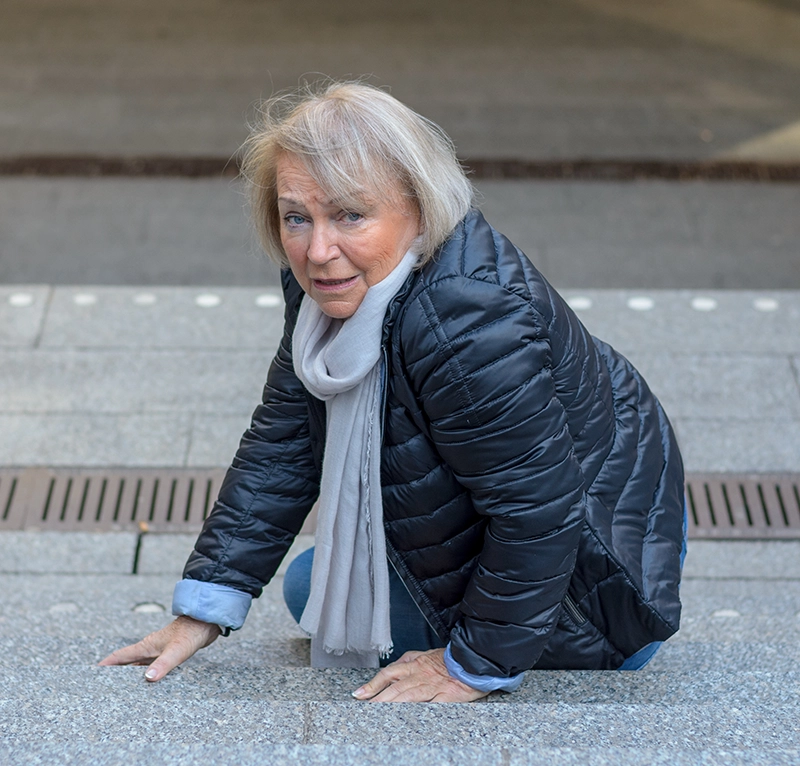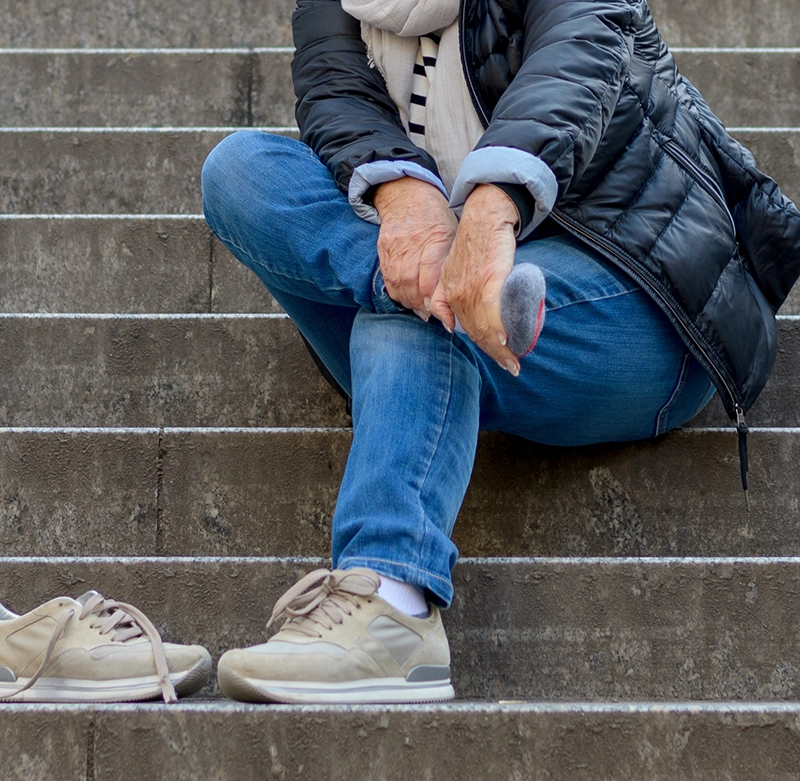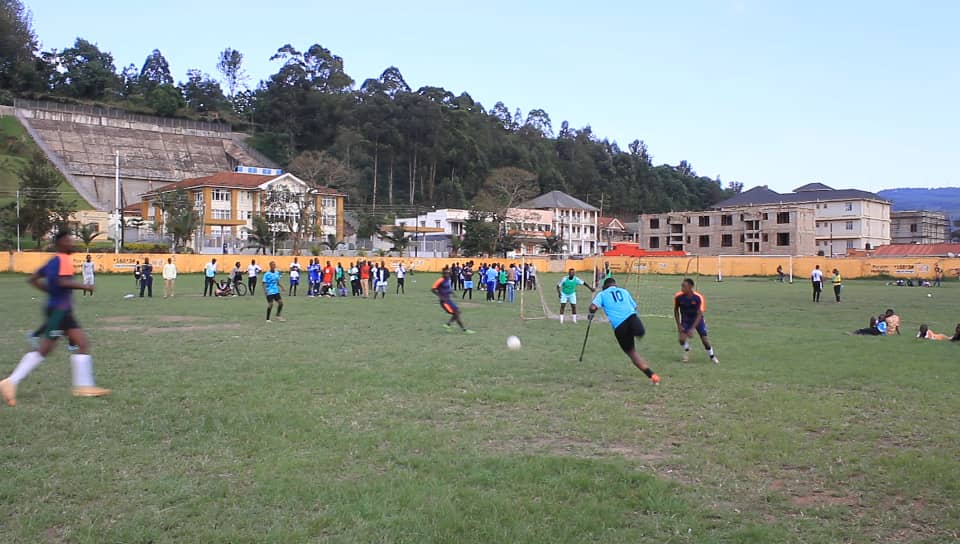When Séamus Kennedy, BEng (Mech), CPed, FAAOP(A), president and co-owner, Hersco Ortho Labs, New York, speaks about fall risk at conferences, the first thing he does is ask his audience if they know someone who has taken a fall that was detrimental to their health.

“Almost everyone puts their hand up,” he says. “It’s either your grandparents or your parents. Once they get to that age, the increased risk of a fall precipitates that there will be some sort of an incident.”
It’s no secret that older adults and those with disabilities, such as those with post-stroke symptoms or related pathologies, are more likely to take a tumble. Unfortunately, it continues to happen, he says.
“I think people know about the problem and it’s discussed, but I’m not sure how motivated people are to do something about the problem,” he says.
Fortunately, experts and studies say that O&P providers have many tools to address the challenge. From identifying patients who may face a risk to finding them supportive and stable footwear, experts say O&P clinicians can play an important role in preventing falls.
“These elderly patients, that’s your mother, that’s my mother, this is very close to home for all of us,” Kennedy says. “Keeping people up and moving helps them live happy and fulfilling lives.”
The Likelihood of Falling
Researchers have determined that falls among older adults are common, costly, and can be physically and psychologically traumatizing.
Studies show:
- Falls are the leading cause of injury for adults ages 65 years and older. They resulted in more than 38,000 deaths in 2021.1
- In 2021, emergency departments recorded nearly 3 million visits for falls among older adults.1
- More than 14 million, or one in four, older adults reported falling in 2020.2
“And as bad as the fall risk is and the fall rate is, the cost of a catastrophic fall is horrendous,” Kennedy says. “You’re talking tens of thousands of dollars to rehab a patient who has fallen and had an injury because of it.”
Studies show the direct cost of inpatient falls exceeds $35,000 per incident.3
Also, as a person ages, their likelihood of falling increases, as does the chance of a worse outcome, Kennedy says.
“There’s a big difference between a 66-year-old falling and an 86-year-old falling. A younger old person who falls might get up again and say, ‘That was silly, I need to pay more attention,’ whereas 20 years later that same person might fall, and it could be devastating.”
Along with the physical pain and cost, falls can also take a psychological toll, the experts say. After a fall, people tend to be more cautious, which can be a good thing, but it can also extend to the point where they are fearful to participate in the daily activities they once enjoyed.
“They don’t walk as far, they don’t see as many people, and their world begins to shrink,” Kennedy says. “But that’s a vicious cycle because they’re less confident so they are not walking so much, but since they are not walking so much, they are less able to walk. And that’s the danger. It’s a huge quality-of-life component.”
Identifying Patients at Risk
Finding a patient who may be at risk of falling isn’t as easy as asking them, Kennedy says. Many times, elderly patients do not want to accept that they have to slow down and, fearing their independence may be taken away, they may lie about previous falls.
However, he says, healthcare professionals can screen older individuals to determine their fall risk. The Centers for Disease Control and Prevention set up a STEADI (Stopping Elderly Accidents, Deaths, and Injuries) initiative, which aims to identify and assist these individuals. Part of the screening is a 12-question checklist, and if the patient is determined to be at risk, a more comprehensive assessment should follow.
O&P experts say there are also other ways to identify these individuals. From the moment customers walk into his store, Robert Schwartz, CPed, president and CEO, Eneslow Pedorthic Enterprises, New York, is looking at the way they walk. Watching them walk as they normally would with their own shoes on is key to seeing issues that might contribute to fall risk, he says.
“Observe them from a distance where they are walking their normal gait,” says Schwartz. “Once you’ve got them in a controlled environment, they are going to walk differently.”
From there, he says, one of the first things he checks is the bottom of their shoes. These can tell an invaluable story about the customer’s overall stability, balance, and gait.
“The shortcut is to look at the wear pattern,” Schwartz says. “If the toe of the shoe is wearing off, they are probably catching their toe and tripping going forward, which is how most people first trip. You look at heel contact moments to see whether people are landing where and when they should be landing (lateral of center) or when they’re already pronated (central or medial heel contact). A pronated foot has no shock absorption from heel contact to foot flat. They’re unstable from heel contact on.”
Many times, symptoms of aging are also symptoms of fall risk, Kennedy says. For example, if patients have limited eyesight, they might trip on something they accidentally step on. If patients are incontinent, they might fall when trying to rush to the restroom. Low blood pressure means that a patient might get lightheaded when standing up.
“What we have to do is to find them and then educate, educate, educate,” Kennedy says.
The Role of Footwear, Orthotics, and Braces
Many factors can contribute to or prevent falls, including footwear, says Stephen O’Hare, president, Pedors Shoes, Georgia. While the right shoe can help someone gain balance and stability, the wrong shoe can also be dangerous, he says.
“You wouldn’t want to put a big, heavy, clunky shoe on an 80-year-old person who can barely lift up their feet,” he says.
Helping people find their ideal shoe for balance and stability depends on several factors including their activity and fitness levels, O’Hare says.
“It depends on what they are capable of and their gait. If they are able to go through heel, midstrike, toe-off, and have a normal gait pattern, then they might need a shoe with more durability and support because they’re more active,” he says. “If they are shuffling around an apartment, they might want to have a shoe that’s easier to get on and off.”
While an above-ankle brace is sometimes needed, that’s not always the case, Schwartz says. Often, physicians prescribe a brace before the patient tries out viable footwear options.
“While most people are provided the brace first,” he says, “a lot of patients who come to us don’t want to wear the brace, but that’s what they were given. Can we help them without the brace? Sometimes yes and sometimes no.”
Factors in Choosing Footwear
There are several elements that experts and studies say should be considered when helping patients find the best shoes to keep them stable, which need to be individualized based on the patient’s needs.
Wearing Footwear
Wearing any shoe is better than no shoe at all, says O’Hare. When older adults are at risk of falling, they should generally be wearing footwear whenever standing, he says. Shoes protect feet from stepping on something that could damage them. Wounds in older adults take longer to heal and longer still if a person has diabetes, he says. Also, if the person is walking around in stocking feet, they are more likely to slip and fall, he adds.
Shoe Fit
If a shoe does not fit properly, it can cause foot pain or instability, which are two factors that contribute to fall risk. Ill-fitting footwear is quite common among older adults, with studies showing 60 percent of participants reporting a bad fit. Well-fitted footwear has proven to improve stability and gait while reducing the fear of falling.4
Adequate Toe Spring
A shoe with enough toe spring—the angle of the toe end of the shoe to the floor—helps people walk and balance better, Schwartz says. “Even for a person with limited dorsiflexion abilities, with more toe spring the shoe will simulate the work of the foot and ankle during the propulsive phase of gait. This is extremely important in fall prevention,” Schwartz says.
Proper Shoe Height and Width
Studies have shown the correlation between the height of the heel and fall risk. Individuals who wear shoes with a 1cm or 3cm elevation showed improved gait stability compared to those wearing 5cm heels. In short, lower shoe elevations substantially reduce fall risk.4
“You don’t want too much of a heel drop; you want it almost flat to increase the stability,” O’Hare says.
Shoes should also be wide enough to contain the foot comfortably. Many seniors have comorbidities that can lead to foot swelling, so they may need wider shoes than other populations.
“You want it fairly wide in the middle to increase the stability,” O’Hare says.
Collar Height
Studies show that shoes with a high collar and top line height can enhance the balance of older adults. A shoe with a higher collar will cover all sides of the ankle and provide mechanical stability to the ankle and subtalar joints in the coronal plane. A higher collar may also enhance proprioceptive feedback, a crucial component for maintaining balance.4
Orthotic Inserts
Orthotic inserts can be helpful for a number of reasons, Kennedy says, including cushioning for foot pain, a key indicator for fall risk.
“You provide relief for the area where the pain is, and you can alleviate the pain for the patient,” Kennedy says. “So they will walk more comfortably, and they’re not compensating for the pain.”
Orthotics that provide arch support can also benefit function by placing the foot in a more optimal position, which helps the user feel more secure and grounded, Kennedy says.
AFOs
While AFOs have been proven to improve balance in patients who may have a neurologic impairment, such as after a stroke, the evidence is less clear about their effects on stability for patients who do not have such impairments.
AFOs can give users additional sensory input, and studies show they can improve postural stability and decrease sway, Kennedy says. However, he warns, given that limited joint range of motion can increase fall risk, it’s important that the AFOs do not restrict ankle motion.
Shoe and Sole Material
Shoes should be cushioned to provide some shock absorption, but they should not be so cushioned that they disrupt sensory feedback for the user, Kennedy says.
“You might step on some stones, and you won’t feel the irregular terrain immediately because of the softness of the sole,” Kennedy says. “As a result, you’re still going to put your foot down with your full weight on it. It might be too late, and you’ll react to the uneven surface, and it might result in a fall.”
Shoe Closure
First and foremost, users have to be able to take their shoes on and off. This can be a challenge for users who have trouble leaning over, finger dexterity issues, or a lot of swelling in their feet.
In some cases, the shoes should be as easy to get on as possible. Pedors Classic MAX Slides have a Velcro strap to tighten the shoe to the foot instead of a back.
“It’s basically just like a big slipper,” O’Hare says. “But if they’re getting up in the middle of the night to go to the bathroom, you want them to be able to slide into their shoe. It reduces the risk of a fall if they are wearing something on their feet.”
Ideally, the users will be able to close any shoe so it is snug on their feet, Kennedy says.
“It can be laces if they are capable of reaching their feet and tying the laces,” he says. “If that’s not the case, Velcro is a very good choice.”
Individualized Solutions
Finding the right solution to mitigate fall risk can be a challenge, but it’s an important one, O’Hare says.

“There’s a lot of moving parts that need to be considered before you can determine the kind of shoe a person needs,” O’Hare says. “At the end of the day, if your prognosis isn’t right, you’re not going to get patient compliance. If it doesn’t solve the problem, they’re not going to wear it. It’s no good if it’s stuffed in a closet. They’ve got to wear it. That’s the key to it all.”
If a solution can be found that works for the individual patient, he or she will be a better walker. And a person who can walk well with confidence is healthier, leaner, more independent, and tends to have a better quality of life, O’Hare says.
“It sounds like a simple thing, but all health starts with the feet.”
_______________________
Foot Problems Associated With an Increased Fall Risk
- Foot pain
- Reduced flexibility in the ankle joint
- Reduced calf muscle strength
- Loss of sensation from neuropathy
- Toe deformities or bunions
Source: Centers for Disease Control and Prevention STEADI initiative
______________________
Screening Assessments
The Centers for Disease Control and Prevention offers screening assessments for healthcare providers to determine whether a patient may have an increased fall risk.
Timed Up and Go Test
To perform this assessment:
- Have the patient sit back in a chair with armrests and identify a line three meters or 10 feet away. The patient should wear his or her regular footwear and can use a walking aid, if needed. Tell the patient to get up from the chair, walk to the line, turn around, walk back, and sit back down.
- Tell the patient to begin, then start the stopwatch. Observe the patient to see if he or she is:
-
- Walking at a slow, tentative pace
- Experiencing a loss of balance
- Taking short strides
- Showing little or no arm swings
- Steadying themselves on walls
- Shuffling
- Record the time when the patient is reseated. An adult who takes longer than 12 seconds to complete the assessment is at risk for falling.
Four-Stage Balance Test
The purpose of this test is to see if a patient can maintain balance with his or her feet in different positions. Patients should not use an assistive device (cane or walker).
To perform this assessment:
- Demonstrate four positions
-
- Standing with feet together
- Place the instep of one foot so it is touching the big toe of the other foot
- Place one foot in front of the other, heel touching toe (tandem stand)
- Stand on one foot (instruct patients that they can hold their arms out for balance, but should keep their feet still)
- If the patient can hold a position for ten seconds without moving his or her feet, go on to the next position. If not, stop the test. An adult who cannot finish the test or cannot hold the tandem stand for ten seconds has an increased risk of falling.
Source: Centers for Disease Control and Prevention STEADI initiative
Maria St. Louis-Sanchez can be contacted at msantray@yahoo.com.
References
- Centers for Disease Control and Prevention, National Center for Injury Prevention and Control. Web–based Injury Statistics Query and Reporting System (WISQARS) [online].
- Kakara, R., G. Bergen, E. Burns, and M. Stevens. 2023. Nonfatal and fatal falls among adults aged ≥65 years—United States, 2020–2021. MMWR Morbidity and Mortality Weekly Report 72:938–43.
- Dykes, P. C., M. Curtin-Bowen, and S. Lipsitz, et. al. 2023. Cost of inpatient falls and cost-benefit analysis of implementation of an evidence-based fall prevention program. JAMA Health Forum 4(1):e225125.
- Kim, I. J., and F. Hegazy. 2024. Enhancing footwear safety for fall prevention in older adults: A comprehensive review of design features. Annals of Geriatric Medicine and Research 28(2):121-33.










-1.png)

.jpg)
